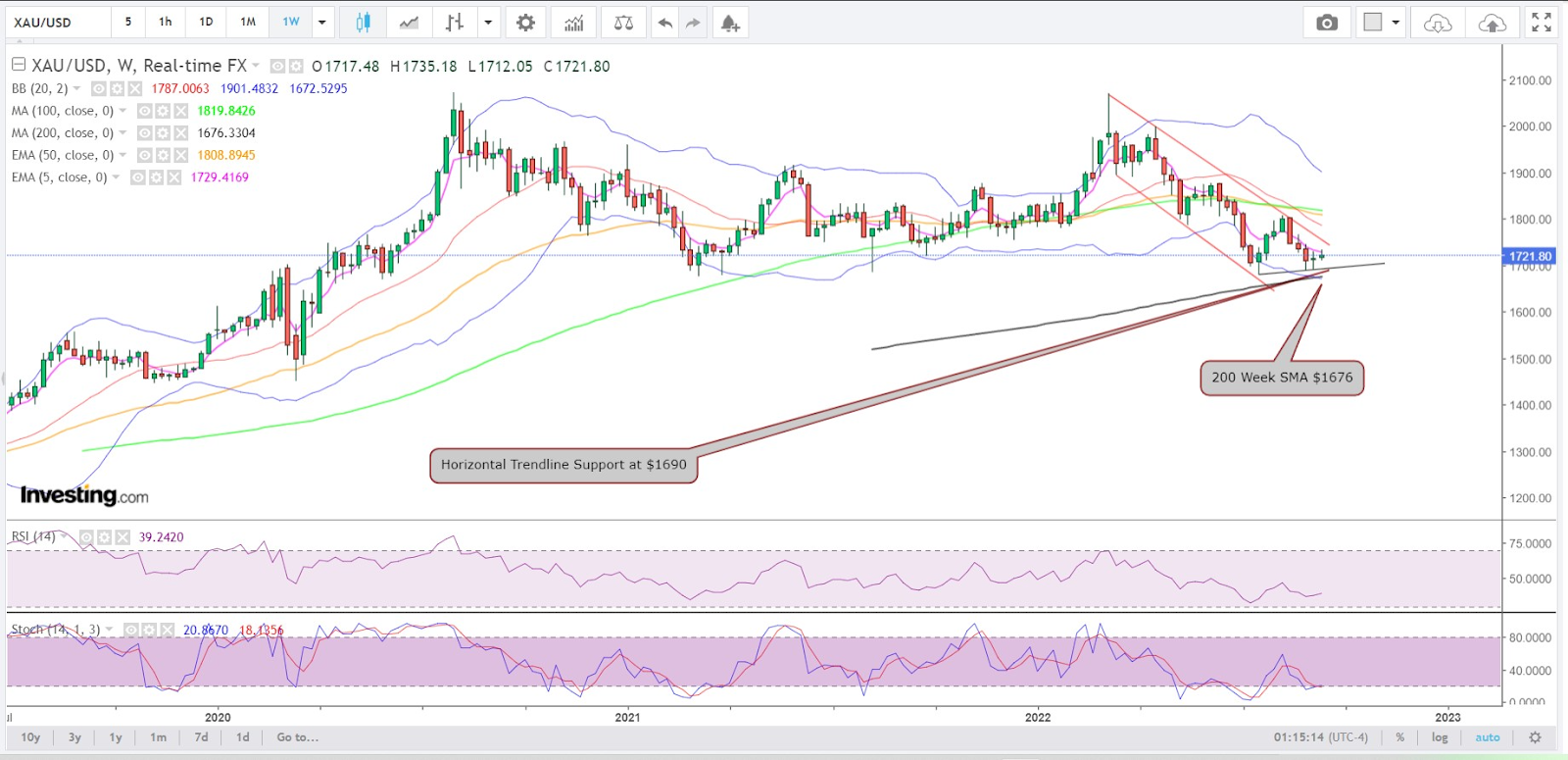Gold: Chart Suggests Bulls ‘Be Patient’ As Metal Holds Above $1,700 Pre-U.S. Fed
2022.09.13 05:58
[ad_1]
The hasn’t exactly crumbled over the past week though the retreat from its 20-year highs has been commendably consistent. There’s something else that has held admirably well for nearly two weeks now: ‘s $1,700 support.
Since hitting a six-week low of $1,688.90 an ounce on Sept. 1, the , which reflects physical trades in bullion, has pointed higher on most days. That has helped set it up for two ultimate tests: Withstanding the negative impact, if any, of today’s U.S. Consumer Price Index (CPI) data as well as the Sept. 21 interest rate decision of the Federal Reserve.
The outcome of these two events will, of course, have quite a say on whether the yellow metal gets to maintain its support and close in on the $1,800 target cherished by bulls.

Charts by SKCharting.com with data powered by Investing.com
Notwithstanding the weaker dollar and slide in U.S. Treasury yields—the latter helping the performance of non-yielding gold—bullion has built decent strength chart-wise, according to those who track its technicals.
Michael Boutros, a technical strategist who blogs on gold, noted that the yellow metal managed to hold above the $1,671/82 level—a weak region defined by the May / June 2020 lows, the 2021 lows and the 38.2% retracement of the 2015 advance.
Boutros added:
“A break below this level would be extremely damaging from a technical standpoint with such a scenario exposing the 2020 March reversal close at $1,631 and the 50% retracement at $1,560.”
“Bottom line: Gold is trading just below yearly channel resistance and the broader focus is a breakout of the $1671-$1762 range for guidance. From a trading standpoint, while the threat remains for a test of key support just lower, respect the break of this medium-term range. Ultimately, gold is testing a major technical pivot zone here—be patient and stay nimble.”
“Being patient” is easier said than done, of course, with gold. Since its amazing breakout to record highs of above $2,100 in August 2020, the price has fallen well short of the lofty targets of its most optimistic investors—despite its standing as a hedge against inflation.
In a near but rare reprisal of its 2020 run, gold got back to nearly $2,100 in March this year, as global commodity markets soared from the supply disruptions caused by Russia’s invasion of Ukraine and the resulting sanctions on Moscow.
Since then, the only thing that has really soared is inflation. Until its recent August update, the closely-watched grew at an annualized rate of 8.5% in July after peaking at 9.1% in June.
The U.S. Federal Reserve has by 225 basis points (bp) in four increases since March, with two back-to-back 75 basis point rises in June and July, in an effort to curb inflation which is growing at its fastest pace in four decades. Money market traders tracked by Investing.com are an 87% probability that the Sept. 21 rate hike will also be a 75 bp increase.
The Fed’s target for inflation is a mere 2% a year and it has vowed to raise interest rates as much as necessary to achieve that.
Economists have cautioned that the Fed could end up pushing the United States into a deeper recession with its sharpest rate hikes in four decades, saying the high-flying housing sector and one-time ebullient stock market could be the central bank’s victims.
Preliminary estimates show the US (GDP), likely contracted by 0.6% in the second quarter after a 1.6% slowdown in the first quarter. Two straight quarters of GDP decline typically places an economy in a recession. Many Fed bankers, however, refute the suggestion of a long and painful recession for the United States.
Where could gold be headed near-term?
Sunil Kumar Dixit, chief technical strategist at SKCharting.com, says gold has done relatively well over the past week but needs to do more to keep the bears at bay.

Most encouraging thus far is gold’s break of the $1,730 resistance, with a test of $1,735, said Dixit referring to the spot price. He, however, adds:
“A close below $1,726 is a caution. Economic data numbers from hereon can flip the short-term rebound and resume the decline.”
A sustained break below $1,715 – $1,707 will prompt a quick retest of the horizontal support trend line at $1,690 and extend to long-awaited 200-Week Simple Moving Average of $1,676, followed by the 50-Month Exponential Moving Average of $1,672, Dixit said.
“The daily stochastics reading of 44/42 moving at 45 degrees shows an advance with a lack of conviction.”
“The weekly stochastics reading of 21/18 is, however, positive and the monthly stochastics reading of 10/13 is close to a positive overlap awaiting consolidation.”
The good news for gold bulls is, either way, there is redemption for them if they are “patient,” says Dixit, using language similar to that of Boutros.
For instance, the weekly and monthly stochastics set-up both indicate a short-term bearish extension for gold, followed by a bullish rebound that could take it toward $1,800, he said.
“Gold can break below the $1,715 – $1,700 and $1,690 support base, followed by a test of the 200-week Simple Moving Average of $1,676 and the 50-month Exponential Moving Average of $1672. However, buyers are very likely to step in around these value areas and a bullish rebound towards $1,800 is likely to start again.”
“In the simplest sense, a break below $1,700 and even a drop to $1,670 is not ruled out. However, the metal is highly likely to bounce back from the lows and resume the journey towards $1,800.”
Disclaimer: Barani Krishnan uses a range of views outside his own to bring diversity to his analysis of any market. For neutrality, he sometimes presents contrarian views and market variables. He does not hold positions in the commodities and securities he writes about.
[ad_2]
Source link








